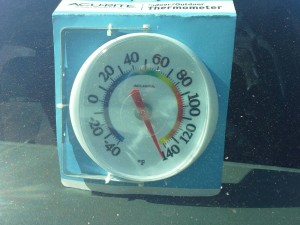Summer Heat in a Closed Vehicle Can Cost your Best Friend its Life
 When “just a few minutes” for a dog sitting in a closed vehicle turns into 5 or 10 minutes, it can become deadly. That’s why Rancho Coastal Humane Society (RCHS) spokesman John Van Zante locked himself in a closed vehicle to show how quickly temperatures can rise to deadly levels. This year’s news conference and demonstration happened on July 2 at RCHS, 389 Requeza Street in Encinitas.
When “just a few minutes” for a dog sitting in a closed vehicle turns into 5 or 10 minutes, it can become deadly. That’s why Rancho Coastal Humane Society (RCHS) spokesman John Van Zante locked himself in a closed vehicle to show how quickly temperatures can rise to deadly levels. This year’s news conference and demonstration happened on July 2 at RCHS, 389 Requeza Street in Encinitas.
Van Zante recalls a family rushing their dog to a veterinary hospital after leaving it in the car. When the family returned, it was too late. A veterinary technician said, “I can’t imagine a worse way for a dog to die.”
Van Zante says the most dangerous part of summer heat for pets (and people) in cars is that the temperature rises so high…and so fast. “A few days ago we put a thermometer in a vehicle in our parking lot. The temperature rose from 80 to 114 degrees in 10 minutes. Three minutes later it hit 119 degrees. That’s enough to kill a dog….or a person. It’s not worth the risk to leave pets or kids in the car while we run into the grocery store for milk and bread.”
Since dogs don’t sweat (except a little through their paws), they pant to cool off. When air temperature is close to body temperature, panting doesn’t help. Heat stroke occurs when a dog’s body cannot cool. That can lead to multiple organ failure.
Symptoms of heat stroke include panting, red guns, irregular heartbeat, and disorientation (almost like your dog looks drunk.)
If your dog shows signs of heat stroke, start by spraying it with cool (not cold) water, wrap it with cool towels, and take it to your veterinarian.
Van Zante reminds dog owners to watch out for hot paws on the sidewalk, pavement, and even sand. “And while we may want to take our dogs along to a picnic or 4th of July fireworks, they’re probably safer at home in a cool, secure area.










You must be logged in to post a comment Login